FraxChain is about to launch, targeting RWA and LSD. How far is Frax from "ranking in the top five by market capitalization"?
Author: Grapefruit, ChainCatcher
Two months after Frax Finance founder Sam Kazemian's live statement that "FXS will rise to become one of the top five or ten crypto assets," Frax has released the V3 version and launched the sFRAX product to enter the RWA track.
sFRAX is a staking vault used to capture the yields of U.S. Treasury bonds, with funds that can purchase short-term risk-free asset products like U.S. Treasury bonds, capturing and tracking Federal Reserve interest rates. As of October 26, the asset amount in the sFRAX staking vault is approximately 39.5 million, with a yield of 6.5%.
However, the deployment of RWA in Frax V3 is just the first move of Q3, with new actions expected to be released in the next two months, which the community views as promising news. Among these, Frax will release the upgraded version of LSD, frxETH V2, in November and launch the Fraxchain testnet in December.
At that time, Frax will become an application that integrates multiple product lines, including "stablecoins, DeFi trifecta, LSD, RWA, and FraxChain." Many opinions suggest that, based on the current product layout, there may still be hope for "FXS to rise to the top five crypto assets by market cap."
Launch of sFRAX to Enter RWA, Frax V3 Has Not Brought TVL Data Growth
The core of Frax V3 is the introduction of RWA business, utilizing the existing AMO automated market operation strategy mechanism to transform the algorithmic stablecoin FRAX into a decentralized stablecoin backed by multiple assets.
In the RWA layout, Frax has launched two product staking vaults: sFRAX and the bond product FXB.
The former, sFRAX, is a staking vault or fund pool aimed at tracking the Federal Reserve's IORB rate, a recognized risk-free rate, allowing on-chain users to enjoy U.S. Treasury bond yields through the FRAX stablecoin.
The specific operational mechanism is that users can stake the stablecoin FRAX in this fund pool to obtain sFRAX staking certificates. The funds in this vault will be used for RWA strategy operations such as U.S. Treasury bonds through Frax's partnered custodian, FinresPBC.
Currently, the main RWA investment asset strategies include: short-term U.S. Treasury bonds, Federal Reserve overnight reverse repurchase agreements, dollars held at the Federal Reserve Bank, and money market funds.
The latter, FXB (FraxBonds), is a tokenized bond product where bondholders will automatically convert to FRAX tokens upon maturity, similar to discounted bonds commonly seen in financial markets. In simple terms, Frax will issue various term bond products FXB, which users can purchase at a discount, and upon maturity, FXB will automatically convert to FRAX tokens.
For example, Frax can support the issuance of 1-year, 2-year, or 3-year Treasury bond FXB. Assuming a face value of 100 FRAX for the FXB bond, generally, the longer the term, the greater the discount. In this case, a 1-year Treasury bond purchase would only require 88 FRAX (12% discount), approximately 70 FRAX for a 2-year bond (20% discount), and only 60 FRAX for a 3-year bond (40% discount). Users can allocate FXB bonds based on their risk tolerance and yield expectations, and regardless of how much FRAX was initially paid, they will ultimately receive 100 FRAX upon FXB maturity.
Whether sFRAX or FXB, they are essentially income-generating tokens, allowing holders to earn RWA-related yields while also participating in on-chain DeFi product interactions to capture on-chain yields or trade in the secondary market, such as providing liquidity for FXB or sFRAX on the Curve platform or supporting exchanges for other tokens.
However, the FXB-related products have not yet officially launched. The sFRAX staking fund pool went live on October 10, with an initial yield of 10%, allowing users to stake FRAX for sFRAX to earn related yields. It is important to note that the yield of the sFRAX fund pool will decrease as the amount of FRAX deposited increases, ultimately aligning with the Federal Reserve's IORB rate (around 5.4%), mostly above IORB. Currently, the total amount of sFRAX in this staking vault is 3,950, with an annual yield of 6.5%.
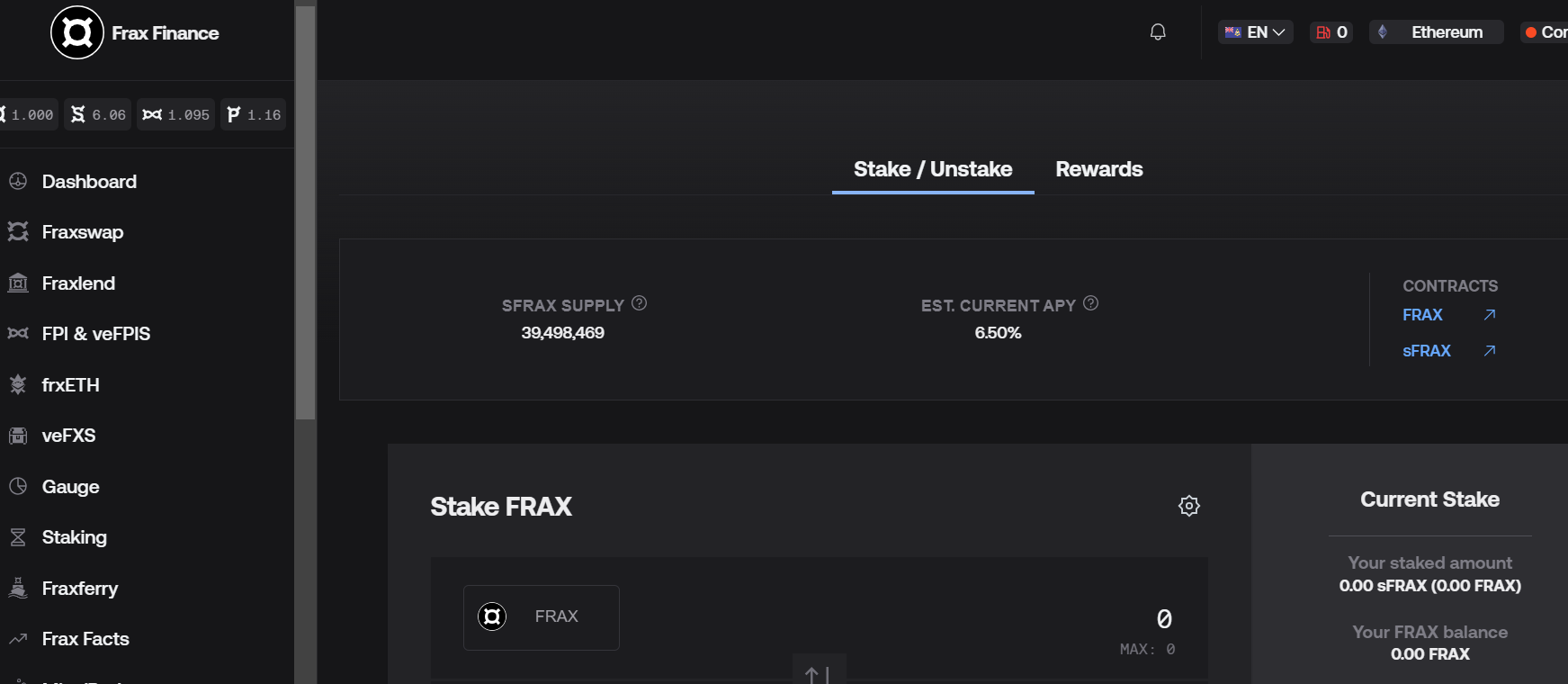
In addition to deploying RWA, Frax V3 has also upgraded the collateral for the algorithmic stablecoin FRAX, adding support for frxETH, sFRAX, and FXB as collateral, making it a more diversified stablecoin.
It is well-known that FRAX initially gained fame as a mixed stablecoin backed by FXS and USDC. Why adjust the strategy now? This can be concluded from the iterative upgrades of the FRAX stablecoin.
In fact, in the V1 version, FRAX gradually reduced the collateral ratio of FXS; in the V2 version, it began to adopt a stablecoin fully backed by USDC and launched the AMO automated execution strategy, which can automatically issue FRAX based on the funding situation of USDC collateral in the vault for on-chain lending or providing liquidity to generate profits, which will be placed in the FRAX vault, cycling to continuously improve capital utilization and increase FRAX scale.
However, in March of this year, the collapse of Silicon Valley Bank severely impacted USDC's peg, and as FRAX was a decentralized stablecoin fully minted from USDC collateral, even with a 100% collateral ratio, it could not escape the impact of the peg. Subsequently, FRAX's minting collateral began a "de-USDC" process, hoping that FRAX could maintain its peg to 1 dollar even in extreme market conditions. At that time, founder Sam stated that FRAX should only have one RWA: depositing dollars into the Federal Reserve Master Account (FMA), meaning that Frax's ultimate solution to the collateral dilemma is to open an FMA and store dollars in the Federal Reserve Master Account. He later stated in the community that FRAX would soon support the purchase of U.S. Treasury bonds.
The Frax V3 version attempts to gradually transform the stablecoin FRAX into a fully externally sourced asset-backed, multi-faceted decentralized stablecoin that can capture both on-chain and off-chain assets. In simple terms, the collateral assets for the FRAX stablecoin will become more diversified, with sFRAX, FXB, and frxETH serving as collateral, where the assets behind sFRAX and FXB represent real-world Treasury bonds and other RWA products, making them safer and more reliable. Through the AMO automated execution strategy, Frax can also capture more profits through sFRAX or FXB to improve the asset collateral ratio (CR) of the FRAX minting vault.
For instance, the AMO strategy can track the Federal Reserve's deposit interest rate (IORB) data, and when the IORB rate increases, the AMO strategy in Frax will use Treasury bills, reverse repurchase agreements, and dollars held at the Federal Reserve Bank that pay the IORB rate as collateral to mint more FRAX for purchasing RWA assets. When the IORB rate decreases, the AMO strategy can use decentralized assets as collateral to balance the collateral ratio of FRAX.
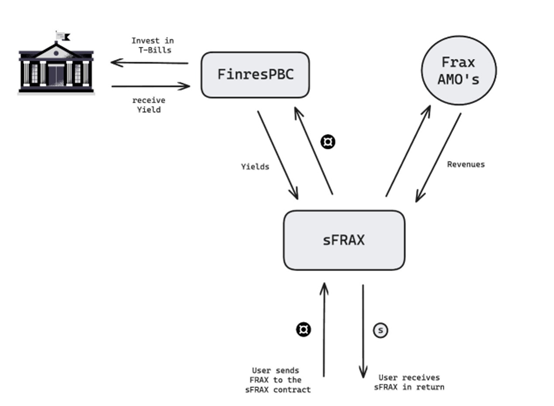
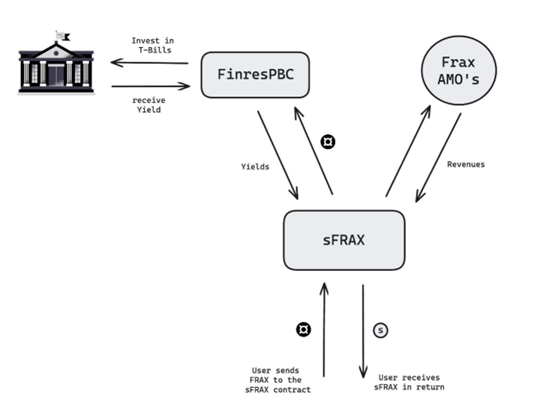
However, more than half a month after the launch of RWA in Frax v3, it has not significantly increased the scale of the stablecoin FRAX, and the TVL of its stablecoin module has remained stable within a certain numerical range. According to DeFiLlama, the value of assets locked in the FRAX protocol has remained stable at around $700 million, and the native governance token FXS has only increased by about 8.6% in the past 14 days.
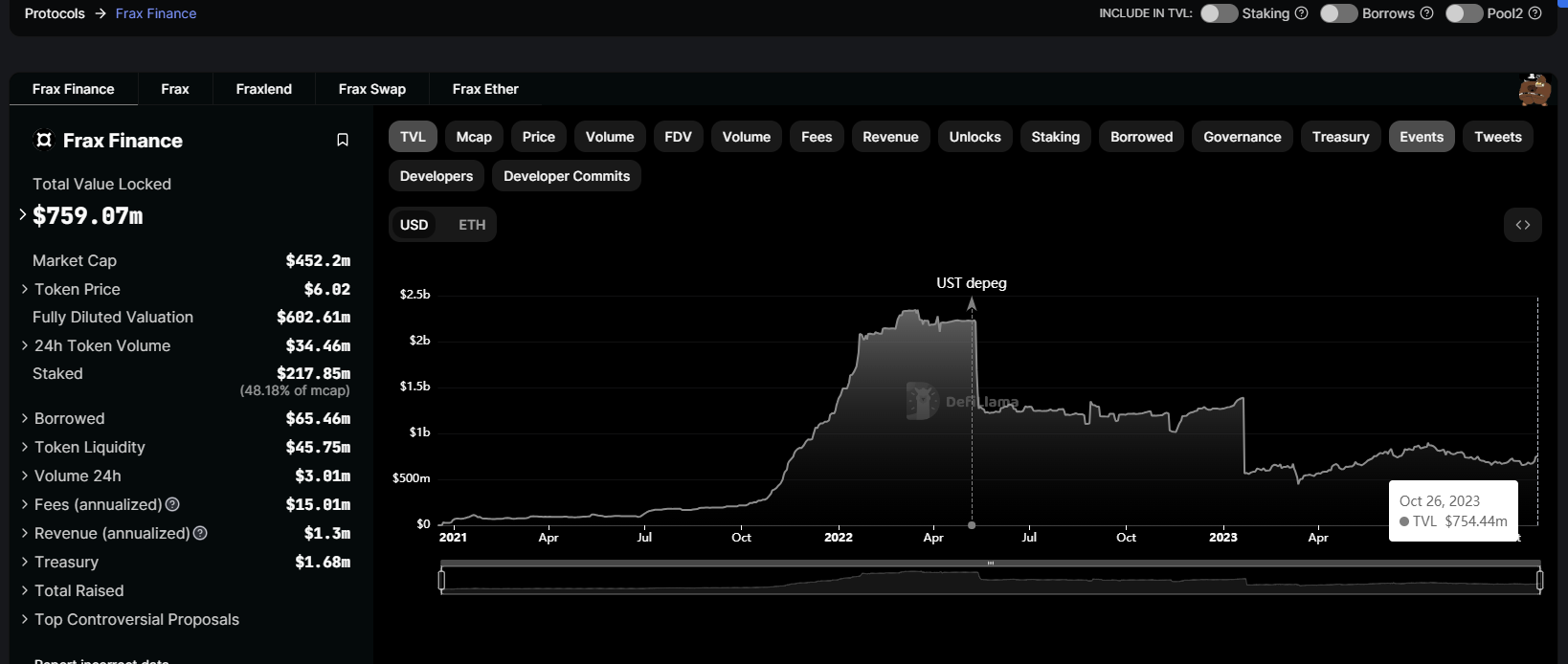
From the protocol data and asset price changes, users' reactions to Frax's release of V3 and the launch of sFRAX for RWA layout have been lukewarm, with no real funds supporting it, performing below expectations.
In response, some users have stated that there is no need to rush, as sFRAX is still an early product, but the long-term layout of RWA is beneficial for Frax.
Upgrading to frxETH V2, Upcoming Launch of FraxChain, Can Frax Overtake?
In addition to deploying RWA business, Frax has two major actions worth looking forward to this year: the upgrade of the LSD product frxETH and the launch of the application chain Fraxchain. According to founder Sam's statements during the live broadcast, the former frxETH will release the V2 version in November, and the application chain Fraxchain is expected to launch its testnet before the end of this year, with the mainnet fully launched in January 2024.
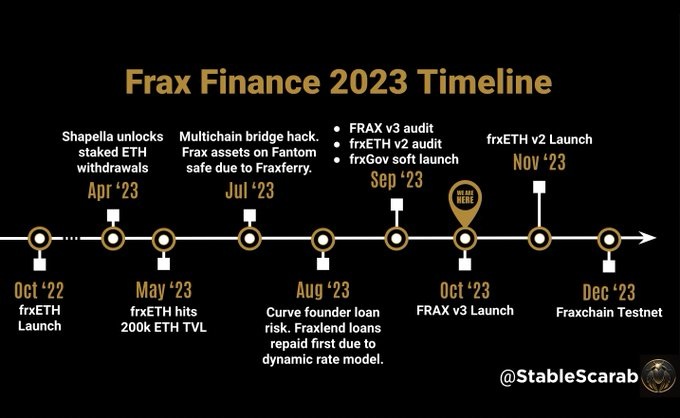
The V2 version of frxETH aims to address centralization issues, as the most criticized aspect of the previous frxETH V1 version was that all Ethereum nodes were operated by its team, resulting in excessive centralization.
In the frxETH V2 version, anyone can run node validators in a permissionless manner, with no whitelist, KYC, or reputation requirements for node operators, ensuring that frxETH nodes can become the highest-performing operators in a decentralized manner.
How is this achieved? The founder of Frax believes that all LSD platforms essentially operate as a peer-to-pool lending market, where users deposit ETH into a fund pool, effectively lending funds to the LSD platform, which then provides users with a loan receipt (liquid staking receipt LST like Lido's stETH), and the borrower rents the deposited ETH and pays interest to the borrower.
For example, Lido's Stake Ether is equivalent to lending ETH to obtain stETH, similar to lending ETH on the Aave lending platform and receiving aETH, except that on Lido, the borrower running Ethereum validation nodes needs to obtain permission; whereas in Rocket Pool's LSD product, users can stake ETH to obtain rETH, i.e., lending ETH to receive the receipt token rETH; and when running a node, they need to provide 8 ETH and then borrow 24 ETH from the staking pool to form 32 ETH, paying interest to the borrower.
Unlike other LSD protocols, the product logic of frxETH is designed with a stablecoin mindset, thus adopting a dual-token model of frxETH and sfrxETH, where frxETH is a stablecoin pegged to ETH, and only by re-staking frxETH can one obtain the income-generating token sfrxETH, i.e., lending frxETH to receive the loan receipt sfrxETH.
Since the LSD protocol can be viewed as a peer-to-pool lending protocol, node operators wishing to borrow validators must adhere to the loan-to-value ratio (LTV) in the loan terms, which refers to the ratio of the loan amount to the value of the collateral, i.e., what proportion of ETH in a validator is borrowed. For example, if Lido's node operator has 32 ETH all borrowed, the LTV is 100%; if Rocket Pool only borrowed 24 ETH, the LTV is 75%. The borrowing interest rate, i.e., the staking yield for users, depends on the capital utilization rate, i.e., the LTV, which is why Lido's yield is higher than Rocket Pool's.
In frxETH V2, users providing small amounts of ETH can be considered collateral (or other collateral approved by veFXS holders in the future) to borrow validators, similar to Rocket Pool. Founder Sam stated during the live broadcast that the plan is to use 4 ETH, so those wishing to become node operators will borrow 28 ETH, paying interest on their PoS earnings. The specific amount of profit ultimately obtained by node operators will depend on their strength and strategy.

In summary, frxETH V2 achieves decentralization by lowering the participation threshold for node operators, allowing ordinary people to become node operators.
Additionally, regarding sfrxETH yields, Frax has designed various strategies to improve capital utilization, such as sending idle ETH not in validators to Curve AMO (automated market operations) to obtain liquidity and yields.
From this perspective, the main goal of frxETH V2 is to lower the participation threshold for node operators, making it more diverse, while employing various strategies to increase the yield of LSD to exceed normal PoS staking yields.
Furthermore, the Fraxchain launching at the end of this year will also use frxETH as a means of paying on-chain GAS fees, which will reduce the supply of frxETH, thereby increasing the yield of sfrxETH and further expanding its LSD market share.
Fraxchain is a Layer 2 solution launched using a hybrid rollup (Optimistic and zk mixed Rollup) scheme. The founder has stated that the revenue generated from this network will flow to the FXS token for burning or distribution to holders.
As of now, the Frax protocol has integrated two stablecoins, FRAX and FPI, along with lending through Fraxlend, trading via Fraxswap, and cross-chain operations through Fraxferry, forming a "DeFi trifecta," along with the LSD product frxETH and RWA products sFRAX and FXB, as well as the application chain Fraxchain.
From the product layout perspective, Frax has gradually developed from a stablecoin starting point into a platform that encompasses numerous applications. Depending on the form of product supply, the Frax platform can be viewed as an asset issuer and management platform, issuing stablecoins like FRAX, frxETH, sFRAX, and building real application scenarios for these assets such as lending, DEX, cross-chain bridges, and chains for collaborative development.

From stablecoins to the "DeFi trifecta," then to LSD, RWA, and the future application chain, Frax's current product line has actually preemptively realized MakerDAO's proposed endgame plan. Unlike MakerDAO, where these component products are implemented through outsourced SubDAOs, such as the lending protocol Spark Protocol launched by Phoenix Labs, Frax's components are all officially issued and uniformly managed and supported by the official team.
Therefore, the interoperability and interaction between products in Frax will be smoother, making it easier to build DeFi-like Lego products. Based on these components, more iterative new products can emerge, which is why Frax has always been regarded as one of the most innovative products by users. However, there are potential issues; a massive system encompassing stablecoins, trading systems, lending systems, cross-chain systems, LSD, and potentially the upcoming Fraxchain requires very high governance standards, necessitating a highly efficient and sound governance module. Additionally, how to isolate risks between different modules to prevent systemic risks that could lead to the collapse of the entire system is particularly important.
Currently, the issuance of FRAX stands at $675 million, ranking seventh in the stablecoin market and second in the decentralized stablecoin track, only behind DAI ($3.77 billion).
How Far is FXS from Rising to the Top Five by Market Cap?
From Frax founder Sam's public statements, the goal for FXS is to become a top five crypto asset by market cap. How far is this goal? We may draw some conclusions from the market scale and data of Frax's representative products.
Currently, among Frax's product components, the stablecoin FRAX protocol has a TVL of $670 million, the LSD product frxETH has locked assets worth $510 million, Fraxswap has locked assets worth $150 million, the lending application FraxLend has a TVL of approximately $240 million, and the anti-inflation stablecoin FPI has assets worth $93 million.

Thus, the total locked asset scale in Frax's entire product system is close to $1.7 billion, approximately $1.66 billion.
If we only measure based on the TVL metric, Frax's asset scale is close to that of Curve (with a TVL of $1.8 billion), but the current circulating market cap of the CRV token is $420 million, ranking 93rd, with a fully diluted market cap of $1.58 billion, while the circulating market cap of the FXS token is $440 million, ranking 91st, with a fully diluted market cap of $590 million.
Assuming both have the same diluted market cap, FXS has about three times the upside potential. However, their ability to capture fees is not the same. According to DeFiLlama, in the past 30 days, the Curve platform captured $3.78 million in fees, while the stablecoin Frax captured only $1.23 million.
In addition, Frax has two key performance indicators: stablecoin market share and LSD market share. Although FRAX is the second-largest decentralized stablecoin, it only holds 0.56% of the stablecoin market share, while DAI accounts for about 3.1%, a difference of six times.
Moreover, in terms of stablecoin scale, FRAX has been significantly affected by MakerDAO's aggressive promotion of RWA business, especially in August this year when the deposit rate (DSR) for DAI in MakerDAO surged to 8%, causing some market participants to shift towards holding DAI for yield. Currently, DAI's DSR has dropped to 5%. However, founder Sam has stated that the operational costs of Frax's RWA partner FinresPBC are much lower than those of competing MakerDAO, suggesting that in the long run, Frax's RWA business may have long-term competitiveness, helping to expand the market scale of the FRAX stablecoin.
In the LSD track, the total amount of ETH locked in frxETH is approximately 280,000, valued at $500 million, with a market share of 2.47% in the LSD market.
From the perspective of product market scale, Frax still has a long way to go to rise to the top five crypto projects by market cap, and the likelihood of achieving this in the short term is quite slim. However, Frax's persistent attitude of continuous innovation has already built a product moat for itself, positioning it as a benchmark model for the future development of DeFi applications.










